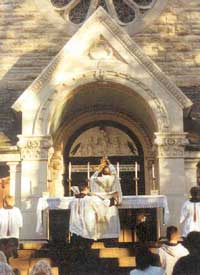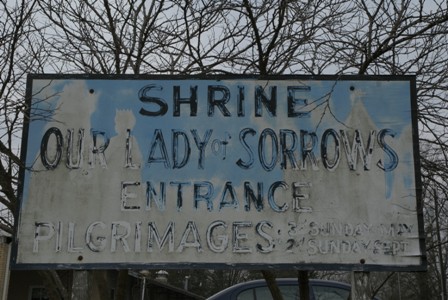
The following is an excerpt of a Starkenburg article that was written a long time ago by Father Novak.
The history of the Shrine of Our Lady of Sorrows in Starkenburg, Missouri, begins in 1887 when Fr. George Hoehn was appointed pastor to St. Martin’s Catholic Church. The church was situated on Missour River bottom lad called Rhineland or Loutre Island (loutre is French for otter), a settled area without a specific name. During the 38 years Fr. Hoehn spent here he became the Shrine’s most zealous publicist.
He was born in Heppenheim in 1856 in the southwest part of Germany. He lost both his parents at the age three. He came to the United States at age 16. He studies for the priesthood at St. Francis Seminary, Milwaukee, Wisconsin, and finished his formation at the University of Louvain in Belgium. He was ordained at age 30 in 1886.
The town name of “Starkenburg” came from Fr. Hoehn. In 1891, he applied for a post ![church-inside[1]](http://www.magnificatmedia.com/wp-content/uploads/2015/10/church-inside1.jpg) office box because of the amount of mail coming into the area and was required to give a name to complete the forms. Looking at the surrounding hills and the St. Martin’s parish church rising high above them, its 125-foot steeple piercing the sky over the river valley, he thought of the likeness to his birthplace in Heppenheim and the hill rising up from it to the fortress called “Starkenburg,” a name meaning “strong fort” in German. The Starkenburg fortress had been built in 1025 by monks of the monastery of Lorsch as protection for the abbey against the political and ecclesiastical machinations of Adalbert, Archbishop of Hamburg-Mainz. After 1232, Starkenburg became a kind of military headquarters for guarding the lands of the Chancellor of the Roman Empire and the Archbishop of Mainz.
office box because of the amount of mail coming into the area and was required to give a name to complete the forms. Looking at the surrounding hills and the St. Martin’s parish church rising high above them, its 125-foot steeple piercing the sky over the river valley, he thought of the likeness to his birthplace in Heppenheim and the hill rising up from it to the fortress called “Starkenburg,” a name meaning “strong fort” in German. The Starkenburg fortress had been built in 1025 by monks of the monastery of Lorsch as protection for the abbey against the political and ecclesiastical machinations of Adalbert, Archbishop of Hamburg-Mainz. After 1232, Starkenburg became a kind of military headquarters for guarding the lands of the Chancellor of the Roman Empire and the Archbishop of Mainz.
Fr. Hoehn died in 1943 and was buried in the convent cemetery of the Precious Blood Sisters at O’Fallon, Missouri. Before he died, he built a small chapel at the base of the Starkenburg hill in Heppenheim. He dedicated it to “Our Lady of Starkenburg, Missouri” and carved for its altar a copy of the White Lady of Starkenburg.
In 1852 the parish church of St. Martin (in what would be finally called Starkenburg) was only a humble log building. It possessed a plain white statue of the Mother of God for whom the German immigrant Catholics of the bottom lands had great devotion. The statue became known as the “White Lady” because of the white veil which adorned it. Our Lady has been known under this name ever since.
In 1873, the original log church of St. Martin’s was replaced by one of stone and soon after a larger statue replaced the While Lady. In 1888, the old faded White Lady was discovered in the rectory attic by August Mitsch, the young nephew of Fr. Hoehn who brought him from Heppenheim to enter religious life in America. ![lady-chapel[1]](http://www.magnificatmedia.com/wp-content/uploads/2015/10/lady-chapel1.jpg) He put the image on a small altar he built under a canopy of dogwood. He started his daily May devotions and was soon joined by children and neighbors. Old timers recognized the While Lady and devotion to her was rekindled in the parishioners. May passed, but instead of returning the image to storage, Mitsch and two seminarians built a small log hut for its protection. Many of the faithful frequented the woodland shrine, and the hut was replaced by the small chapel shrine. This chapel shrine still stands.
He put the image on a small altar he built under a canopy of dogwood. He started his daily May devotions and was soon joined by children and neighbors. Old timers recognized the While Lady and devotion to her was rekindled in the parishioners. May passed, but instead of returning the image to storage, Mitsch and two seminarians built a small log hut for its protection. Many of the faithful frequented the woodland shrine, and the hut was replaced by the small chapel shrine. This chapel shrine still stands.
In 1889, on the Feast of Seven Sorrows of Our Lady (September 15th), the first Way of the Cross was erected with the approval of St. Louis Archbishop Peter Kenrick in the woods near the Lady Chapel. ![via-crucis[1]](http://www.magnificatmedia.com/wp-content/uploads/2015/10/via-crucis1.jpg) The woodland received a special blessing and no cattle or vehicles were permitted to cross the premises. At this time, between the first and last Stations, an underground sepulcher was built where an image of the dead Christ lies with a Calvary grouping erected atop it.
The woodland received a special blessing and no cattle or vehicles were permitted to cross the premises. At this time, between the first and last Stations, an underground sepulcher was built where an image of the dead Christ lies with a Calvary grouping erected atop it.
Over the years the image of the White Lady had begun to look weather-beaten. In 1890, Catholics from St. Louis donated an image of the Pieta from Dusseldorf, Germany, to the Shrine. It was made in Dusseldorf, Germany. It was used in processions and is now enshrined on a side altar of the 1910 church. The While Lady was once again retired to storage.
In 1891, six weeks of rain halted the building of a tower and addition to the old St. Martin’s parish church and threatened to destroy the harvest. Fr. Hoehn invited the parish to join him in vowing to sponsor an annual pilgrimage in honor of Our Lady of Sorrows if the imminent danger were averted. And it was. The rains subsided and a bumper wheat crop was harvested. In the same year, the parish gave thanks for three days ending with a solemn procession to the log Lady Chapel in the woods. While numerous private pilgrimages had been made already by parishioners, this was the first public pilgrimage observed in Starkenburg. A year later, 40 Catholics from Hermann, Missouri, were the first non-parishioners to make the pilgrimage as part of a mission conducted by two Redemptoriest priests.
On July 27, 1897, Pope Leo XIII officially granted plenary indulgences, at certain times and under the usual conditions of a good Confession, reception of Holy Communion, and prayers before the holy image of the Pieta, to pilgrims who visited the Shrine. This further encouraged pilgrimages to Starkenburg.
![pilgrimage[1]](http://www.magnificatmedia.com/wp-content/uploads/2015/10/pilgrimage1.jpg) Up until now, some maintained that Starkenburg was not a genuine place of pilgrimage, much less a place of grace. Fr. Hoehn prayed that some sign of authenticity might be granted from Heaven. There was no water at the Grotto and he prayed to the Blessed Mother for a fountain of fresh water. Against the protests of area famers who disbelieved water would be found here, a well was dug at the site. After three days digging, on September 3, 1900, the Feast of Mary, Comfortress of the Afflicted, a spring was struck. The next year, a drought came upon the area, cisterns and creeks went dry, but not the Lourdes Well. Shortly after the well had been dug, Fr. Hoehn went to France. To affiliate the Starkenburg well with that of Lourdes, he brought back from Lourdes a large container of its water which he poured into the Starkenburg well. No official claims have ever been made for healing power either by drinking or touching the water of the Starkenburg Lourdes Well, but there war reports of cures. A notable case is that of Sr. Vera, a Loretto sister teaching at Webster College, Kansas City, who visited the Grotto in 1940 suffering from a large cyst in the throat which was to require a serious operation. She drank the water of the Starkenburg well. Upon presenting herself for the operation, no trace of the cyst could be found. In 1970, Sr. Vera signed a statement testifying that no sign of the cyst had returned. Crutches, braces, and marble plaques line the walls of the side chapel of the Pieta, bearing testimony to the faith and gratitude of the pilgrims who obtained consolation and relief through the intercession of Our Lady.
Up until now, some maintained that Starkenburg was not a genuine place of pilgrimage, much less a place of grace. Fr. Hoehn prayed that some sign of authenticity might be granted from Heaven. There was no water at the Grotto and he prayed to the Blessed Mother for a fountain of fresh water. Against the protests of area famers who disbelieved water would be found here, a well was dug at the site. After three days digging, on September 3, 1900, the Feast of Mary, Comfortress of the Afflicted, a spring was struck. The next year, a drought came upon the area, cisterns and creeks went dry, but not the Lourdes Well. Shortly after the well had been dug, Fr. Hoehn went to France. To affiliate the Starkenburg well with that of Lourdes, he brought back from Lourdes a large container of its water which he poured into the Starkenburg well. No official claims have ever been made for healing power either by drinking or touching the water of the Starkenburg Lourdes Well, but there war reports of cures. A notable case is that of Sr. Vera, a Loretto sister teaching at Webster College, Kansas City, who visited the Grotto in 1940 suffering from a large cyst in the throat which was to require a serious operation. She drank the water of the Starkenburg well. Upon presenting herself for the operation, no trace of the cyst could be found. In 1970, Sr. Vera signed a statement testifying that no sign of the cyst had returned. Crutches, braces, and marble plaques line the walls of the side chapel of the Pieta, bearing testimony to the faith and gratitude of the pilgrims who obtained consolation and relief through the intercession of Our Lady.
In 1925, Fr. Hoehn sought the help of a religious order to entrust care of the Shrine. An invitation was accepted by the Oblates of Mary who had a Minor Seminary in nearby Belleville, Illinois, and who knew the Shrine well. The Oblates were charged to care for the Shrine for 35 years.
Remarkable among the Oblates who did this was Fr. Aloysius Rosenthal, who was responsible for the Shrine from 1934 – 1943. These years saw a heavy influx of pilgrims. A special KATY Railroad train was run on the two big pilgrimage days, the third Sunday in May and the second Sunday in September. As many as 3,000 people attended these annual pilgrimages regularly.
Lets try and build the Starkenburg Pilgrimage up to 3,000 people again. Be an Apostle! Let’s show Our Lord and Our Lady of Sorrows how much we love them and make reparation for the world. The pilgrimage starts Thursday, September 1st, 2016 at 1:00pm through Saturday, September 3rd at 4:00pm. You may either attend the one day or three day pilgrimage. For more detailed information and to contact Joe Spencer please go to this link: Starkenburg Pilgrimage

